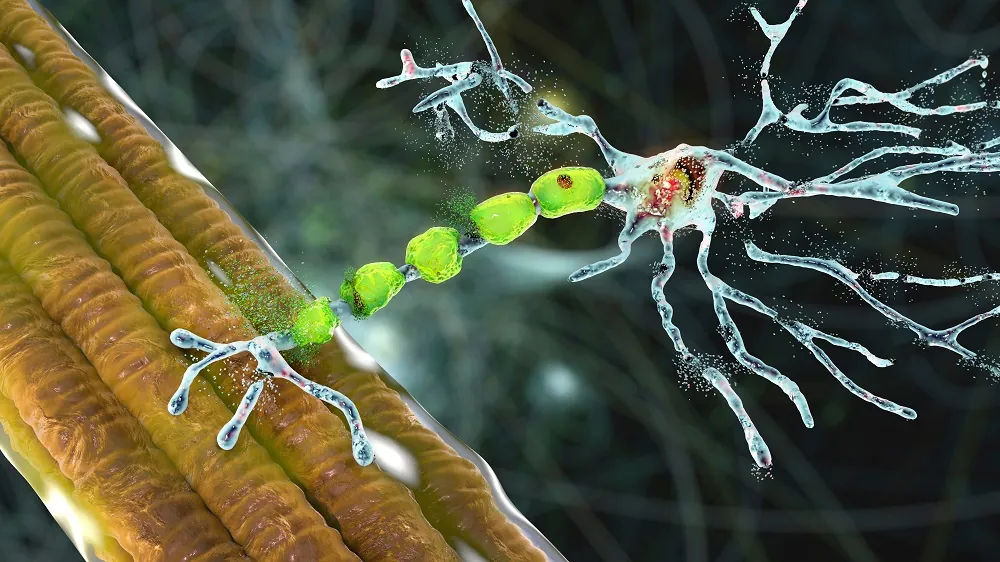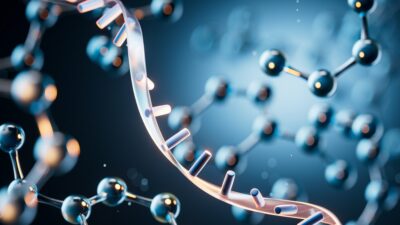Cryptic Exons for Targeting Neurodegenerative Disease
- This approach affects only a tiny fraction of cells.

Amyotrophic lateral sclerosis (ALS) only affects a fraction of cells and must be treated with high specificity. Scientists have achieved that by targeting mRNA sites associated with the disease [1].
Cryptic behavior
ALS is a neurodegenerative disease in which age is a major factor. While it can be diagnosed at almost any age, the average age of onset is 55. ALS is debilitating and sometimes life-threatening, and finding cures for it can be relevant to other neurodegenerative conditions as well.
ALS is associated with the loss of function of the protein TDP-43 in a subset of motor neurons. This protein’s role protects the basics of DNA transcription. When a gene is transcribed into RNA, the resulting molecule contains exons, the parts that will be included in the mature messenger RNA (mRNA) after splicing, and introns, the parts that will be discarded.
However, introns themselves may contain parts that can be mistaken for exons by the transcription machinery. These “cryptic exons” can scramble the final transcript, resulting in a dysfunctional protein.
TDP-43 protects the cell from cryptic exons, so, when it goes bad, all hell breaks loose. Aggregates of dysfunctional TDP-43 are found in almost all cases of ALS [2], but also in about half of the cases of frontotemporal dementia. It has also been linked to Alzheimer’s disease [3].
A guided weapon
Gene therapy has been helpful in conditions that involve loss of function in proteins, but the problem is in ALS, only a tiny fraction of neurons is affected, so the therapy must be precisely targeted. “While neurodegenerative diseases have devastating effects, we can estimate that less than 0.00001% of cells in a patient’s body are actually diseased,” said Oscar Wilkins, leading author on a new study published in Science, in which researchers from the Francis Crick Institute and the UCL Queen Square Institute of Neurology have described a novel method of targeting.
The researchers created viral vectors that, in addition to the therapeutic cargo, such as a transgene that codes for functional TDP-43, carry a particular cryptic exon sequence, found in the gene AARS1. The vectors are designed in a way that only allows transcription of the cargo when the cryptic exon sequence is not silenced – that is, in cells where TDP-43 is not working properly.
First, the researchers included a fluorescent protein, mCherry, as cargo to see how specific their construct is. A massive increase in both mCherry expression and the cryptic exon expression was detected in cells with TDP-43 knocked down. However, even in cells with normal TDP-43, some “leaky expression” occured, which was addressed by subsequent tweaks. Including additional cryptic exons further increased specificity. Similar results were achieved in mice with TDP-43 knocked out.
However, TDP-43 knockout is a less than perfect model of ALS. A closer fit would be cells with dysfunctional, aggregated TDP-43. Working on human embryonic kidney cells, the researchers were able to mimic ALS-like TDP-43 dysfunction. In those cells, the viral vectors got activated as well, “strongly suggesting this approach will function within ALS and FTD patients.”
Precision is the key
The researchers performed two other interesting experiments with different therapeutic cargoes. In one, they loaded the vectors with DNA-editing machinery and were able to remove cryptic splice sites – again, only in cells where TDP-43 didn’t perform well. In another, they used a transgene that codes for a modified TDP-43 that is less prone to aggregation.
“Gene therapy holds promise for treating neurodegenerative diseases like ALS and FTD, which are relatively common but for which there are few treatments,” said Claire Le Pichon from the Eunice Kennedy Shriver National Institute of Child Health and Human Development, NIH, who was an American collaborator on the study.
“TDP-43 controls many aspects of cellular health, and its dysfunction is a key driver of disease. Therefore, correcting TDP-43 function only in the cells that have lost it is an important step toward a safer precision medicine. Successful therapies depend on thorough preclinical studies, and we look forward to additional work to validate and build upon our findings.”
Disease-induced activation of gene therapies at single-cell resolution could help mitigate the potential risks of permanent transgene expression in patients. Furthermore, in at-risk individuals carrying causal genetic variants of ALS, the spatial and temporal specificity of TDP-REG could allow the therapeutics to be delivered at the presymptomatic stage, lying dormant until the very first stages of TDP-43 pathology are detected. Additionally, TDP-REG can be used during the preclinical phase of drug development as a real-time readout for TDP-43 pathology in cells or even live animals.
Literature
[1] Wilkins, O. G., J. Chien, Z. Y., Wlaschin, J. J., Barattucci, S., Harley, P., Mattedi, F., Mehta, P. R., Pisliakova, M., Ryadnov, E., Keuss, M. J., Thompson, D., Digby, H., Knez, L., Simkin, R. L., Diaz, J. A., Zanovello, M., Brown, L., Darbey, A., Karda, R., . . . Fratta, P. (2024). Creation of de novo cryptic splicing for ALS and FTD precision medicine. Science.
[2] Scotter, E. L., Chen, H. J., & Shaw, C. E. (2015). TDP-43 proteinopathy and ALS: insights into disease mechanisms and therapeutic targets. Neurotherapeutics, 12(2), 352-363.
[3] McAleese, K. E., Walker, L., Erskine, D., Thomas, A. J., McKeith, I. G., & Attems, J. (2017). TDP‐43 pathology in Alzheimer’s disease, dementia with Lewy bodies and ageing. Brain pathology, 27(4), 472-479.








